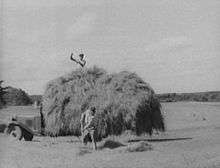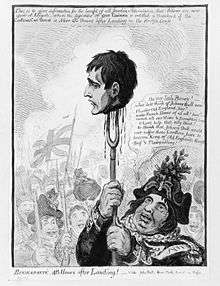Pitchfork
A pitchfork is an agricultural tool with a long handle and two or three tines used to lift and pitch or throw loose material, such as hay, straw or leaves.

The term is also applied colloquially, but inaccurately, to the garden fork. While similar in appearance, the garden fork is shorter and stockier than the pitchfork, with three or four thicker tines intended for turning or loosening the soil of gardens.
Pitchforks appear in artworks whose subject is associated with agriculture.
Alternate terms
In some parts of England, a pitchfork is known as a prong.[1] In parts of Ireland, the term sprong is used to refer specifically to a four-pronged pitchfork.[2]
Description
The typical pitchfork consists of a fork bearing two tines fixed to one end of a handle. Pitchfork tines are typically made of metals such as steel, wrought iron, or some other alloy, though wood or bamboo tines may also be employed. The handle of a pitchfork is commonly made of wood, sometimes sheathed or shielded with rubber or plastic.
True pitchforks typically have two or three tines while manure forks have four or more. However, some forks with more than three tines are also used for handling loose material such as hay or silage.[3] Other forks may exhibit up to ten tines.
The number of tines and the spacing between them is determined by the intended usage of the fork. Forks with larger numbers of tines and closer spacing are intended to carry or move loose material such as dirt, sand, silage, or large, coarse grains. Forks with fewer, more widely spaced tines are intended to hold hay, straw, and other self-supporting or bulky materials.[3]
History
In Europe, the pitchfork was first used in the early Middle Ages, at about the same time as the harrow.[4] Such pitchforks were made entirely of wood, lacking the metal tines of later pitchforks.[3]
Historically, pitchforks were occasionally employed as improvised weapons by individuals who could not afford or did not have access to specialized, more expensive weapons such as swords or guns.[5] As a result, pitchforks and scythes are stereotypically carried by angry mobs or gangs of enraged peasants.
In popular culture

Artwork

A notable American artistic display of a three-pronged pitchfork is in the painting American Gothic (1930) by Grant Wood. There are other paintings by various artists which depict a wide variety of pitchforks and other tools in use and at rest.[6]
Politics
Because of its association with peasantry and farming, the pitchfork has been used as a populist symbol and appended as a nickname for certain leading populist figures, such as "Pitchfork" Ben Tillman and "Pitchfork" Pat Buchanan.
The Gangster Disciples, a street gang in the midwestern United States, use a three-pointed pitchfork as one of their symbols.[7]
Venezuelan far-right political party, New Order use three-pointed pitchfork as their symbols.
Religious symbolism
The pitchfork is often used in lieu of the trident in popular portrayals and satire of Christian demonology. Many humorous cartoons, both animated and otherwise, feature a caricature of a demon supposedly wielding a "pitchfork" (often actually a trident) sitting on one shoulder of the protagonist, opposite an angel on the other shoulder.
The Hellenistic deity Hades wields a bident, a two-pronged weapon similar in form to a pitchfork but actually related to the trident in design and purpose.
See also
References
| Wikimedia Commons has media related to Pitchforks. |
- Copper, Bob (1975). A Song for Every Season: A Hundred Years of a Sussex Farming Family. Paladin, St. Albans, Hertfordshire. p. 112. Retrieved August 26, 2019.
- Joyce, P. W. (2009). English As We Speak It in Ireland. Read Books. p. 832. Retrieved August 26, 2019.
- Rhode, Dr. Robert T. (October 1996). "Why All Pitchforks Are Not Alike". Farm Collector. Retrieved February 4, 2016.
- McNeill, J. R; Stewart Mauldin, Erin (November 2012). A Companion to Global Environmental History (1st ed.). Wiley-Blackwell. p. 342. ISBN 9781118977538.
- "Medieval Men". Medieval-Period.com. Retrieved February 13, 2014.
- Ritch, Alan (February 6, 2006). "Resting in the hay (1592-1900)". Hay In Art. Retrieved February 13, 2014.
- Gutierrez, Carl D. "Asset Protection for the 21st Century" (PDF). Food Marketing Institute. Food Marketing Institute. Retrieved 27 August 2019.